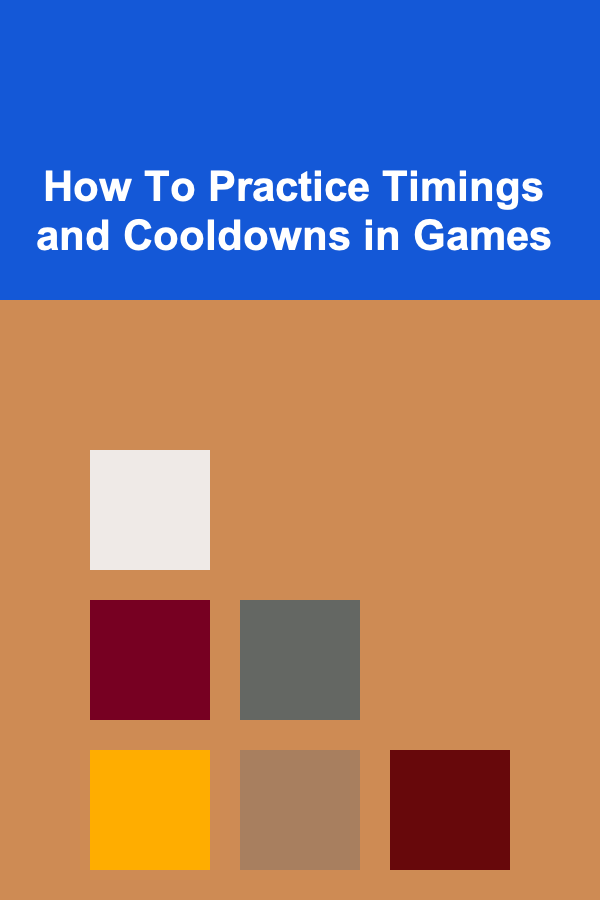
How To Practice Timings and Cooldowns in Games
ebook include PDF & Audio bundle (Micro Guide)
$12.99$9.99
Limited Time Offer! Order within the next:

In the world of competitive gaming, timing and cooldown management can often be the difference between victory and defeat. Whether you're playing real-time strategy games, first-person shooters, or massively multiplayer online games (MMOs), understanding how to optimally manage your character's abilities, spells, and actions is essential to success. In this article, we will explore how to practice timings and cooldowns in games effectively, providing practical strategies, training methods, and tips that can help you gain a competitive edge.
What Are Timings and Cooldowns in Games?
Before we dive into how to practice timings and cooldowns, it is important to define what these terms mean within the context of gaming.
- Timings: In gaming, timings refer to the precise moments or intervals during gameplay when certain actions or abilities should be executed. This includes things like knowing when to use an ability or attack, when to retreat, or when to initiate certain actions based on the game environment or the enemy's actions.
- Cooldowns: Cooldowns refer to the time periods during which a specific ability or action is unavailable after it has been used. In most games, abilities or spells are designed with cooldowns to prevent players from spamming them endlessly, adding an element of strategy and requiring players to time their actions carefully.
These two elements are critical to mastering gameplay, as they influence how efficiently a player can utilize their resources and abilities.
Why Are Timings and Cooldowns Important?
Effectively managing timings and cooldowns can greatly enhance your performance in a game. Some of the benefits include:
- Maximizing Damage Output: In games with combat mechanics, particularly MOBAs (Multiplayer Online Battle Arenas) and MMORPGs, the timing of your attacks and ability usage can significantly affect your damage output. Mismanaging your cooldowns or failing to use abilities at the right time can waste potential damage and hinder your team's overall performance.
- Effective Resource Management: Many games feature limited resources, whether that be mana, energy, or ammunition. Understanding when to use certain abilities and when to conserve resources is essential for effective gameplay.
- Improving Survival: Knowing when to use defensive abilities, healing spells, or cooldowns to escape danger can often mean the difference between life and death in a game. Timely use of cooldowns for crowd control, healing, or evasive maneuvers can save you from being eliminated.
- Strategic Gameplay: Timing your abilities in sync with your team's actions or your enemy's mistakes can create openings for major advantages. Whether you're coordinating with teammates in a team-based game or predicting enemy actions, timing and cooldown management is key to turning the tide in your favor.
- Preventing Overcommitment: Many games feature abilities or spells that can be "over-committed" if used recklessly. Understanding your cooldowns and how much time you have until they're available again helps prevent you from committing to a fight or action that you can't finish, resulting in a wasted effort or an untimely defeat.
Now that we know the importance of timings and cooldowns, let's explore how to practice them effectively.
Mastering the Basics of Cooldowns
The first step to improving your cooldown management is to have a deep understanding of the abilities at your disposal.
Understand the Cooldowns
Every game has different abilities, and each has its own cooldown timer. Spend time learning the cooldowns of each ability your character or unit has. Knowing these numbers off by heart allows you to play more effectively without having to constantly check the ability timer.
Practical Tip:
- Create a "Cooldown Chart": In complex games with multiple abilities, it can be helpful to keep a mental or even physical list of your character's cooldowns. This will help you visualize when each ability is available and ensure that you're using them effectively.
Consider Ability Synergies
In many games, certain abilities work better when used in combination with others. Some abilities may have a longer cooldown but deal much more damage or provide a greater strategic advantage. Practicing your timing for these synergies helps ensure that you are maximizing your potential during fights or objectives.
Practical Tip:
- Practice Combos: Set up training scenarios where you can practice executing ability combos. Doing so will help you better time your abilities and cooldowns during a real match.
Early and Late Game Differences
Many games feature different phases of play, such as early, mid, and late game, and the way cooldowns function during each phase can differ significantly. For example, some characters or units might have stronger cooldown abilities later in the game but weaker ones at the start.
Practical Tip:
- Adapt to Game Phases: Adjust your playstyle based on the phase of the game. Early on, focus on conserving abilities and using them for key objectives. In the late game, you can afford to be more aggressive with your abilities.
Creating Effective Timings
Timing is crucial, especially in games that require quick reactions and precise execution. Here are some ways to improve your timing.
Predict Enemy Movements
In games with combat or strategy mechanics, anticipating the movements and decisions of your opponents is a valuable skill. Knowing when to time your abilities for maximum effect can turn a fight in your favor.
Practical Tip:
- Practice Predictive Skills: Train yourself to anticipate enemy movements, especially when they are about to use an ability or make a play. For example, if you know an enemy is likely to use a crowd control ability, time your escape or counterplay for that moment.
Learn to Use Ability "Windows"
Some abilities or attacks have small windows of opportunity where they are most effective. These windows might be extremely brief, so practicing and understanding when to execute these abilities can give you a significant advantage.
Practical Tip:
- Time Your Abilities: Some games require you to use an ability right when an enemy is about to strike or make an aggressive move. For instance, in fighting games, a well-timed counterattack or block can completely negate an opponent's move.
Think Ahead, Not Just In the Moment
It is not enough to think about what is happening right in front of you. A successful player thinks several steps ahead. By understanding the cooldowns of both your abilities and your opponents', you can plan out your next few actions.
Practical Tip:
- Anticipate Enemy Cooldowns: Try to keep track of what your enemies are using and when they used their abilities. This will allow you to take advantage of their cooldowns and find openings in their defense.
Practicing Timings and Cooldowns in Training
Now that we know the importance of timing and cooldown management, let's talk about how to practice these aspects in a more structured way.
Training Mode
Most games have a training mode that allows you to practice without the pressure of a live match. Take advantage of this mode to get a feel for the cooldowns and timings of different abilities.
Practical Tip:
- Repeatability: Focus on specific abilities and practice their timings repeatedly. Try to execute each ability as efficiently as possible within its cooldown window.
Scenario-Based Practice
Another way to improve your timing is to practice specific scenarios that might occur in real games. For instance, practicing a sudden engagement with an enemy or using a defensive ability right after a teammate is incapacitated can help you react faster during a match.
Practical Tip:
- Simulate Real Situations: Create specific training scenarios that mimic what you might face in a competitive match. For example, practice escaping from a team fight, using your abilities optimally, and keeping track of cooldowns while managing your positioning.
Use of Hotkeys and Macros
Many competitive games allow you to assign specific abilities to hotkeys. Learning how to quickly access your abilities and knowing when to press them is crucial for effective timing. Using macros or programmable keys can also help you streamline your actions and improve your responsiveness.
Practical Tip:
- Customize Your Keybindings: Tailor your keybindings to suit your playstyle. A comfortable setup will help you focus on your cooldowns and timing rather than fumbling with controls during a fight.
Review Your Gameplay
After each match, take some time to review your gameplay and identify moments where you could have timed your abilities better. Look for missed opportunities where you could have used a cooldown more effectively or a time when you might have wasted an ability due to poor timing.
Practical Tip:
- Watch Replays: Many games provide replay features that allow you to watch past matches. Analyze your performance, paying particular attention to how you managed your timings and cooldowns.
Common Mistakes to Avoid
While practicing timing and cooldowns, players often make common mistakes. Here are a few that you should try to avoid:
- Using Abilities Too Early: Using your abilities too soon can result in them being on cooldown for longer than necessary. Be patient and wait for the optimal moment to strike.
- Overestimating Cooldowns: Sometimes, players forget how long a cooldown really is and engage in actions that they can't follow through with because the ability isn't ready yet. Always be aware of your cooldown timers.
- Not Communicating with Teammates: In team-based games, poor communication about your cooldowns can lead to wasted opportunities. Always keep your teammates in the loop about your cooldowns and be aware of theirs.
Conclusion
Practicing timings and cooldowns is a crucial aspect of mastering competitive gaming. By developing a deeper understanding of your abilities, predicting enemy actions, and using training modes effectively, you can improve both your individual performance and your contributions to team efforts. Timing and cooldown management might seem like subtle elements of gameplay, but when mastered, they can give you a significant edge over your opponents. The key is consistent practice, awareness, and adaptation to the ever-changing dynamics of competitive gaming.

How to Make Your Bathroom Feel More Spacious with Organization
Read More
How to Soundproof Your Home Against Street Traffic Noise
Read More
How to Use Neutral Colors to Create a Universally Appealing Home
Read More
How to Transition from Manual to Digital Civil Drafting
Read More
How to Build a Film Editing Reel That Gets You Hired
Read More
10 Tips for Dealing with Noisy HVAC Equipment
Read MoreOther Products

How to Make Your Bathroom Feel More Spacious with Organization
Read More
How to Soundproof Your Home Against Street Traffic Noise
Read More
How to Use Neutral Colors to Create a Universally Appealing Home
Read More
How to Transition from Manual to Digital Civil Drafting
Read More
How to Build a Film Editing Reel That Gets You Hired
Read More